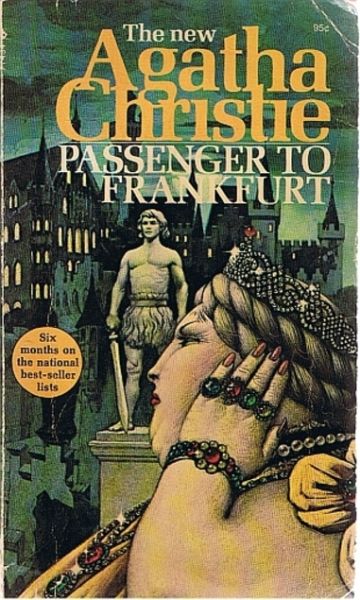In the Arms of the Angel
Passenger to Frankfurt
By Agatha Christie

14 Oct, 2018
Because My Tears Are Delicious To You
0 comments
Agatha Christie’s 1970 Passenger to Frankfurt is a standalone thriller and dystopian novel.
Sir Stafford Nye’s diplomatic career is less due to any aptitude for the job and more because in the gently declining post-Empire world, no better candidate presented themself for the job. On his way back from another fairly pointless summit in Malaya, Nye’s one noteworthy characteristic catches the eye of a desperate spy.
His bold fashion sense.
Spoilers follow.
Nye favours traveling cloaks and burnooses. That combined with their curiously similar features inspires the operative known as “Mary Ann” (AKA Countess Renata Zerkowski, AKA Daphne Theodofanous) to approach him with a desperate plea: let her borrow Nye’s outer clothes and passport so she can escape her enemies. On a whim, Nye acquiesces.
Much to Nye’s relief, the sleeping tablet Mary Ann put into his drink is indeed a sleeping tablet. He wakes some hours later with a headache. The authorities seem to accept his version of events at face value. Mary Ann even returns his passport, hidden in a magazine. Many people might have let the whole affair drop there.
Nye does not. Instead, he tries to make contact with Mary Ann. Success draws him into a world of international espionage. A high-stakes game is unfolding. The Old Order offers little of interest to the Youth of Today. Their need for some dramatic new cause is being manipulated by the morbidly obese and entirely evil Countess Charlotte von Waldsausen, to sinister ends.
Governments around the world teeter on edge of collapse. The fate of the world depends on the combined efforts of a disparate assortment of jaded functionaries, lady spies, researchers, and Nye’s determined Great-Aunt Martha. If they fail, the world will fall into the hands of the secret masters of the student movements: Nazis!
~oOo~
Countess Charlotte von Waldsausen is not a subtly drawn villain.
While the idea of young people around the world suddenly embracing fascism seems ludicrous, it’s important to remember that this was written only a quarter of a century after the end of WWII, when many of the people who backed Nazi Germany were still alive.
Christie did not often dabble in dystopian science fiction. In fact, if there is a second example, I do not know of it. Not only does the novel detail a worldwide transformation in the political landscape, but the ultimate solution to the problem of those darn kids is entirely technological in nature.
The solution is very similar to one that plays a central role in John Brunner’s 1973 The Stone That Never Came Down, in which the drug VC enhances empathy. In this novel, the drug Benvo turns people altruistic. While Benvo does not at first seem to have any negative side effects, it is a plot point that it has not been thoroughly tested. There are also ethical concerns re doping people into compliance. The drug has languished in development limbo, but the threat of an international cabal of baby Nazis leads to new efforts.
Christie does not explore the long-term consequences of taking Benvo. That’s just one of the ways in which the book is rather a muddle. There are some interesting passages in Passenger but they do not really join up into a coherent whole. The end result is more akin to notes for an interesting thriller (with occasional rants about Kids These Days) than an actual novel. Pity, because I rather liked Great-Aunt Martha and her determination to save the world from the machinations of her long-time frenemy Countess Charlotte von Waldsausen. The idea that history is shaped by a boarding school rivalry seems amusing enough. It’s a pity it (and other themes) are not developed more effectively.
Researchers have suggested that Christie might have suffered from some degree of dementia in her later days. If so, that may explain some of the issues evident in this novel.
Passenger to Frankfurt is available here (Amazon) and here (Chapters-Indigo).
